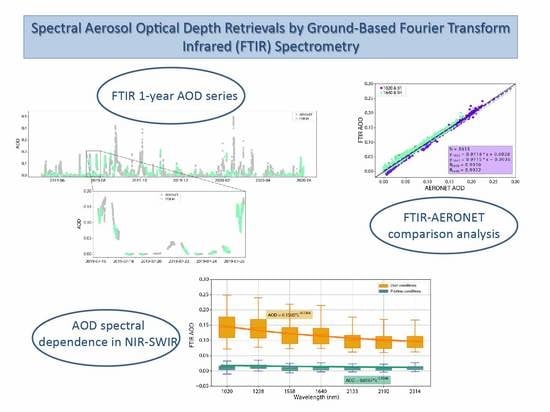Spectral Aerosol Optical Depth Retrievals by Ground-Based Fourier Transform Infrared Spectrometry
Abstract
1. Introduction
2. Test Site
3. FTIR
4. Ancillary Information
4.1. Cimel CE318-AERONET
4.2. MOPSMAP
5. Methodology
5.1. FTIR Micro-Windows Selection
5.2. FTIR Absolute Calibration and AOD Calculation
5.3. FTIR Ångström Exponent (AE) Calculation
5.4. FTIR Cloud Mask and Quality-Control Procedure
- Cloud mask: 1-min measurements of co-located global and diffuse short-wave downward radiation (SDR) have been used to screen clouds following [94]. This cloud-screening method is based on the approach suggested by [95], with four individual tests applied to the normalized global and maximum diffuse SDRs in addition to the temporal change in global SDR and the normalized diffuse variability in SDR.
- Quality-control: it basically analyzes the quality of the FTIR interferograms and the Langley absolute calibration.
- (a)
- DC-Quality Parameter: the implemented DC correction on the raw FTIR interferograms allows a DC-quality parameter to be defined for identifying and filtering out unstable interferograms. This parameter accounts for intensity variations of the recorded DC signal. A maximum variability of 0.10 has been set (i.e., 10% intensity variation in the co-added interferogram), which ensures high-quality FTIR spectra.
- (b)
- Flag for non-valid Langleys: This empirical flag has been included to account for those important changes in which can affect the instrument’s calibration in nearby days. This is the case of 26 February 2020, after a severe dust outbreak, and 4 April 2020, after the FTIR’s external mirrors were cleaned.
5.5. Limitations in FTIR AOD Retrievals
6. Results
6.1. FTIR Absolute Calibration
6.2. FTIR AOD Retrievals
6.3. FTIR AE Retrievals
7. Summary and Conclusions
Author Contributions
Funding
Acknowledgments
Conflicts of Interest
References
- Bojinski, S.; Verstraete, M.M.; Peterson, T.C.; Richter, C.G.; Simmons, A.; Zemp, M. The Concept of Essential Climate Variables in Support of Climate Research, Applications, and Policy. Bull. Am. Meteorol. Soc. 2014, 95, 1431–1443. [Google Scholar] [CrossRef]
- Boucher, O.; Randall, D.; Artaxo, P.; Bretherton, C.; Feingold, G.; Forster, P.; Kerminen, V.M.; Kondo, Y.; Liao, H.; Lohmann, U.; et al. Clouds and Aerosols. In Climate Change 2013: The Physical Science Basis. Contribution of Working Group I to the Fifth Assessment Report of the Intergovernmental Panel on Climate Change; Stocker, T., Qin, D., Plattner, G.K., Tignor, M., Allen, S., Boschung, J., Nauels, A., Xia, Y., Bex, V., Midgley, P., Eds.; Cambridge University Press: Cambridge, UK; New York, NY, USA, 2013; Chapter 7; pp. 571–658,. [Google Scholar] [CrossRef]
- Myhre, G.; Shindell, D.; Breon, F.M.; Collins, W.; Fuglestvedt, J.; Huang, J.; Koch, D.; Lamarque, J.F.; Lee, D.; Mendoza, B.; et al. Anthropogenic and Natural Radiative Forcing. In Climate Change 2013: The Physical Science Basis. Contribution of Working Group I to the Fifth Assessment Report of the Intergovernmental Panel on Climate Change; Stocker, T., Qin, D., Plattner, G.K., Tignor, M., Allen, S., Boschung, J., Nauels, A., Xia, Y., Bex, V., Midgley, P., Eds.; Cambridge University Press: Cambridge, UK; New York, NY, USA, 2013; Chapter 8; pp. 659–740. [Google Scholar] [CrossRef]
- Remer, L.A.; Kaufman, Y.J.; Tanré, D.; Mattoo, S.; Chu, D.A.; Martins, J.V.; Li, R.R.; Ichoku, C.; Levy, R.C.; Kleidman, R.G.; et al. The MODIS Aerosol Algorithm, Products, and Validation. J. Atmos. Sci. 2005, 62, 947–973. [Google Scholar] [CrossRef]
- Panicker, A.S.; Pandithurai, G.; Safai, P.D.; Kewat, S. Observations of enhanced aerosol longwave radiative forcing over an urban environment. Geophys. Res. Lett. 2008, 35. [Google Scholar] [CrossRef]
- Scott, V.C.A.C.M.P.C.C.R.A.L.C.N. Infrared dust aerosol optical depth retrieved daily from IASI and comparison with AERONET over the period 2007–2016. Remote Sens. Environ. 2018, 15–32. [Google Scholar] [CrossRef]
- Kim, J.; Yoon, J.; Ahn, M.H.; Sohn, B.J.; Lim, H.S. Retrieving aerosol optical depth using visible and mid-IR channels from geostationary satellite MTSAT-1R. Int. J. Remote Sens. 2008, 29, 6181–6192. [Google Scholar] [CrossRef]
- Clarisse, L.; Coheur, P.F.; Prata, F.; Hadji-Lazaro, J.; Hurtmans, D.; Clerbaux, C. A unified approach to infrared aerosol Remote Sens. and type specification. Atmos. Chem. Phys. 2013, 13, 2195–2221. [Google Scholar] [CrossRef]
- Ryder, C.L.; Highwood, E.J.; Walser, A.; Seibert, P.; Philipp, A.; Weinzierl, B. Coarse and giant particles are ubiquitous in Saharan dust export regions and are radiatively significant over the Sahara. Atmos. Chem. Phys. 2019, 19, 15353–15376. [Google Scholar] [CrossRef]
- O’Neill, N.T.; Eck, T.F.; Reid, J.S.; Smirnov, A.; Pancrati, O. Coarse mode optical information retrievable using ultraviolet to short-wave infrared Sun photometry: Application to United Arab Emirates Unified Aerosol Experiment data. J. Geophys. Res. Atmos. 2008, 113. [Google Scholar] [CrossRef]
- Toledano, C.; Torres, B.; Velasco-Merino, C.; Althausen, D.; Groß, S.; Wiegner, M.; Weinzierl, B.; Gasteiger, J.; Ansmann, A.; González, R.; et al. Sun photometer retrievals of Saharan dust properties over Barbados during SALTRACE. Atmos. Chem. Phys. 2019, 19, 14571–14583. [Google Scholar] [CrossRef]
- Kok, J.F.; Ridley, D.A.; Zhou, Q.; Miller, R.L.; Zhao, C.; Heald, C.L.; Ward, D.S.; Albani, S.; Haustein, K. Smaller desert dust cooling effect estimated from analysis of dust size and abundance. Nat. Geosci. 2017, 10, 274–278. [Google Scholar] [CrossRef]
- Does, M.; Knippertz, P.; Zschenderlein, P.; Harrison, R.; Stuut, J.B. The mysterious long-range transport of giant mineral dust particles. Sci. Adv. 2018, 4. [Google Scholar] [CrossRef]
- Hess, M.; Koepke, P.; Schult, I. Optical Properties of Aerosols and Clouds: The Software Package OPAC. Bull. Am. Meteorol. Soc. 1998, 79, 831–844. [Google Scholar] [CrossRef]
- Koepke, P.; Hess, M.; Schult, I.; Shettle, E.P. Global Aerosol Data Set; Technical Report 243, MPI Meteorologie Hamburg Report; MPI: Vaudreuil, QC, Canada, 1997. [Google Scholar]
- Gasteiger, J.; Wiegner, M. MOPSMAP v1.0: A versatile tool for the modeling of aerosol optical properties. Geosci. Model Dev. 2018, 11, 2739–2762. [Google Scholar] [CrossRef]
- Holben, N.B.; Eck Slutsker, T.F.A.; Tanre, I.A.; Buis, D.A.; Setzer, J.P.A.; Vermote, A.A.; Reagan, E.A.; Kaufman, J.A.A.; Nakajima, Y.J.A. AERONET—A Federated Instrument Network and Data Archive for Aerosol Characterization. Remote Sens. Environ. 1998, 1–16. [Google Scholar] [CrossRef]
- Takamura, T.; Sasano, Y.; Hayasaka, T. Tropospheric aerosol optical properties derived from lidar, sun photometer, and optical particle counter measurements. Appl. Opt. 1994, 33, 7132–7140. [Google Scholar] [CrossRef]
- WMO. Aerosol Measurement Procedures, Guidelines and Recommendations; Technical Report GAW Report No. 153; WMO TD No. 1178; World Meteorological Organization: Geneva, Switzerland, 2003. [Google Scholar]
- Bevan, S.L.; North, P.R.; Los, S.O.; Grey, W.M. A global dataset of atmospheric aerosol optical depth and surface reflectance from AATSR. Remote Sens. Environ. 2012, 199–210. [Google Scholar] [CrossRef]
- Huang, J.; Kondragunta, S.; Laszlo, I.; Liu, H.; Remer, L.A.; Zhang, H.; Superczynski, S.; Ciren, P.; Holben, B.N.; Petrenko, M. Validation and expected error estimation of Suomi-NPP VIIRS aerosol optical thickness and Ångström exponent with AERONET. J. Geophys. Res. Atmos. 2016, 121, 7139–7160. [Google Scholar] [CrossRef]
- Peyridieu, S.; Chédin, A.; Capelle, V.; Tsamalis, C.; Pierangelo, C.; Armante, R.; Crevoisier, C.; Crépeau, L.; Siméon, M.; Ducos, F.; et al. Characterisation of dust aerosols in the infrared from IASI and comparison with PARASOL, MODIS, MISR, CALIOP, and AERONET observations. Atmos. Chem. Phys. 2013, 13, 6065–6082. [Google Scholar] [CrossRef]
- Aumann, H.; Chahine, M.; Gautier, C.; Goldberg, M.; Kalnay, E.; McMillin, L.; Revercomb, H.; Rosenkranz, P.W.; Smith, W.L.; Staelin, D.H.; et al. AIRS/AMSU/HSB on the Aqua mission: Design, science objectives, data products, and processing systems. IEEE Trans. Geosci. Remote Sens. 2003, 41, 253–264. [Google Scholar] [CrossRef]
- Chahine, M.T.; Pagano, T.S.; Aumann, H.H.; Atlas, R.; Barnet, C.; Blaisdell, J.; Chen, L.; Divakarla, M.; Fetzer, E.J.; Goldberg, M.; et al. AIRS: Improving Weather Forecasting and Providing New Data on Greenhouse Gases. Bull. Am. Meteorol. Soc. 2006, 87, 911–926. [Google Scholar] [CrossRef]
- Crevoisier, C.; Clerbaux, C.; Guidard, V.; Phulpin, T.; Armante, R.; Brice, B.; Camy-Peyret, C.; Chaboureau, J.P.; Dufour, G.; Lavanant, L.; et al. The IASI-NG mission onboard METOP-SG: Scientific objectives and expected results. In Proceedings of the 3rd Conference IASI, Hyères, France, 4–8 February 2013. [Google Scholar]
- Tanré, D.; Kaufman, Y.J.; Herman, M.; Mattoo, S. Remote Sens. of aerosol properties over oceans using the MODIS/EOS spectral radiances. J. Geophys. Res. Atmos. 1997, 102, 16971–16988. [Google Scholar] [CrossRef]
- Ruddick, Q.V.K. Advantages of high quality SWIR bands for ocean colour processing: Examples from Landsat-8. Remote Sens. Environ. 2015, 89–106. [Google Scholar] [CrossRef]
- Cao, C.; De Luccia, F.J.; Xiong, X.; Wolfe, R.; Weng, F. Early On-Orbit Performance of the Visible Infrared Imaging Radiometer Suite Onboard the Suomi National Polar-Orbiting Partnership (S-NPP) Satellite. IEEE Trans. Geosci. Remote Sens. 2014, 52, 1142–1156. [Google Scholar] [CrossRef]
- Kaufman, Y.J.; Tanré, D.; Remer, L.A.; Vermote, E.F.; Chu, A.; Holben, B.N. Operational Remote Sens. of tropospheric aerosol over land from EOS moderate resolution imaging spectroradiometer. J. Geophys. Res. Atmos. 1997, 102, 17051–17067. [Google Scholar] [CrossRef]
- Barreto, A.; Cuevas, E.; Granados-Muñoz, M.J.; Alados-Arboledas, L.; Romero, P.; Gröbner, J.; Kouremeti, N.; Almansa, A.; Stone, T.; Toledano, C.; et al. The new sun-sky-lunar Cimel CE318-T multiband photometer—A comprehensive performance evaluation. Atmos. Meas. Tech. 2016, 9, 631–654. [Google Scholar] [CrossRef]
- Giles, D.M.; Sinyuk, A.; Sorokin, M.G.; Schafer, J.S.; Smirnov, A.; Slutsker, I.; Eck, T.F.; Holben, B.N.; Lewis, J.R.; Campbell, J.R.; et al. Advancements in the Aerosol Robotic Network (AERONET) Version 3 database—Automated near-real-time quality control algorithm with improved cloud screening for Sun photometer aerosol optical depth (AOD) measurements. Atmos. Meas. Tech. 2019, 12, 169–209. [Google Scholar] [CrossRef]
- Flynn, C.J.; Russell, P.B.; Schmid, B.; Redemann, J.; Dunagan, S.E.; Kluzek, C.D.; Hubbe, J.M.; Segal-Rosenheimer, M.; Livingston, J.M.; Eck, T.F.; et al. Hyperspectral aerosol optical depths from TCAP flights. J. Geophys. Res. Atmos. 2013, 118, 12180–12194. [Google Scholar] [CrossRef]
- Witthuhn, J.; Deneke, H.; Macke, A.; Bernhard, G. Algorithms and uncertainties for the determination of multispectral irradiance components and aerosol optical depth from a shipborne rotating shadowband radiometer. Atmos. Meas. Tech. 2017, 10, 709–730. [Google Scholar] [CrossRef]
- Redemann, J.; Zhang, Q.; Schmid, B.; Russell, P.B.; Livingston, J.M.; Jonsson, H.; Remer, L.A. Assessment of MODIS-derived visible and near-IR aerosol optical properties and their spatial variability in the presence of mineral dust. Geophys. Res. Lett. 2006, 33. [Google Scholar] [CrossRef]
- Hase, F.; Hannigan, J.W.; Coffey, M.T.; Goldman, A.; Hopfner, M.; Jones, N.B.; Rinsland, C.P.; Wood, S.W. Intercomparison of retrieval codes used for the analysis of high-resolution, ground-based FTIR measurements. J. Quant. Spectrosc. Radiat. Transf. 2004, 25–52. [Google Scholar] [CrossRef]
- Schneider, M.; Blumenstock, T.; Chipperfield, M.P.; Hase, F.; Kouker, W.; Reddmann, T.; Ruhnke, R.; Cuevas, E.; Fischer, H. Subtropical trace gas profiles determined by ground-based FTIR spectroscopy at Izaña (28deg; N, 16deg; W): Five-year record, error analysis, and comparison with 3-D CTMs. Atmos. Chem. Phys. 2005, 5, 153–167. [Google Scholar] [CrossRef]
- Schneider, M.; Sepúlveda, E.; García, O.; Hase, F.; Blumenstock, T. Remote Sens. of water vapour profiles in the framework of the Total Carbon Column Observing Network (TCCON). Atmos. Meas. Tech. 2010, 3. [Google Scholar] [CrossRef]
- Schneider, M.; Demoulin, P.; Sussmann, R. Fourier Transform Infrared Spectrometry, in Monitoring Atmospheric Water Vapour Ground-Based Remote Sensing and In Situ Methods; Technical Report; Springer: New York, NY, USA, 2013. [Google Scholar]
- Wunch, D.; Toon, G.C.; Blavier, J.F.L.; Washenfelder, R.A.; Notholt, J.; Connor, B.J.; Griffith, D.W.T.; Sherlock, V.; Wennberg, P.O. The Total Carbon Column Observing Network. Philos. Trans. A Math. Phys. Eng. Sci. 2011, 369, 2087–2112. [Google Scholar] [CrossRef] [PubMed]
- García, O.E.; Sepúlveda, E.; Schneider, M.; Hase, F.; August, T.; Blumenstock, T.; Kühl, S.; Munro, R.; Gómez-Peláez, A.J.; Hultberg, T.; et al. Consistency and quality assessment of the Metop-A/IASI and Metop-B/IASI operational trace gas products (O3,CO, N2O, CH4, and CO2) in the subtropical North Atlantic. Atmos. Meas. Tech. 2016, 9, 2315–2333. [Google Scholar] [CrossRef]
- De Mazière, M.; Thompson, A.M.; Kurylo, M.J.; Wild, J.D.; Bernhard, G.; Blumenstock, T.; Braathen, G.O.; Hannigan, J.W.; Lambert, J.C.; Leblanc, T.; et al. The Network for the Detection of Atmospheric Composition Change (NDACC): History, status and perspectives. Atmos. Chem. Phys. 2018, 18, 4935–4964. [Google Scholar] [CrossRef]
- Höpfner, M.; Blumenstock, T.; Hase, F.; Zimmermann, A.; Flentje, H.; Fueglistaler, S. Mountain polar stratospheric cloud measurements by Ground Based FTIR Solar Absorption Spectroscopy. Geophys. Res. Lett. 2001, 28, 2189–2192. [Google Scholar] [CrossRef]
- Holben, B.N.; Eck, T.F.; Slutsker, I.; Smirnov, A.; Sinyuk, A.; Schafer, J.; Giles, D.; Dubovik, O. Aeronet’s Version 2.0 quality assurance criteria. Proc. SPIE 2006, 6408. [Google Scholar] [CrossRef]
- Köhler, C.H.; Trautmann, T.; Lindermeir, E.; Vreeling, W.; Lieke, K.; Kandler, K.; Weinzierl, B.; Groß, S.; Tesche, M.; Wendisch, M. Thermal IR radiative properties of mixed mineral dust and biomass aerosol during SAMUM-2. Tell. B Chem. Phys. Meteorol. 2011, 63, 751–769. [Google Scholar] [CrossRef]
- Hedelius, J.K.; Toon, G.C.; Wennberg, P.O. Estimating AOD from an EM27/SUN. In Proceedings of the NDACC/IRWG and TCCON Meeting, Paris, France, 29 May–2 June 2017. [Google Scholar]
- WMO/GAW Experts Workshop on a Global Surface-Based Network for Long Term Observations of Column Aerosol Optical Properties; Technical Report GAW Report No. 162; WMO TD No. 1287; World Meteorological Organization: Davos, Switzerland, 2005.
- Eck, T.F.; Holben, B.N.; Reid, J.; Dubovik, O.; Smirnov, A.; Neill, N.; Slutsker, I.; Kinne, S. Wavelength dependence of the optical depth of biomass burning, urban, and desert dust aerosols. J. Geophys. Res. 1999, 104, 31333–31349. [Google Scholar] [CrossRef]
- O’Neill, N.T.; Dubovik, O.; Eck, T.F. Modified Ångström exponent for the characterization of submicrometer aerosols. Appl. Opt. 2001, 40, 2368–2375. [Google Scholar] [CrossRef]
- Schuster, G.L.; Dubovik, O.; Holben, B.N. Angstrom exponent and bimodal aerosol size distributions. J. Geophys. Res. Atmos. 2006, 111. [Google Scholar] [CrossRef]
- Ångström, A. The parameters of atmospheric turbidity. Tellus 1964, 16, 64–75. [Google Scholar] [CrossRef]
- Dubovik, O.; Holben, B.; Eck, T.F.; Smirnov, A.; Kaufman, Y.J.; King, M.D.; Tanré, D.; Slutsker, I. Variability of Absorption and Optical Properties of Key Aerosol Types Observed in Worldwide Locations. J. Atmos. Sci. 2002, 59, 590–608. [Google Scholar] [CrossRef]
- Toledano, C.; Wiegner, M.; Garhammer, M.; Seefeldner, M.; Gasteiger, J.; Müller, D.; Koepke, P. Spectral aerosol optical depth characterization of desert dust during SAMUM 2006. Tellus B 2009, 61, 216–228. [Google Scholar] [CrossRef]
- Basart, S.; Pérez, C.; Cuevas, E.; Baldasano, J.; Gobbi, G. Aerosol characterization in Northern Africa, Northeastern Atlantic, Mediterranean Basin and Middle East from direct-sun AERONET observations. Atmos. Chem. Phys. 2009, 9, 8265–8282. [Google Scholar] [CrossRef]
- Cuevas, E.; Gómez-Peláez, A.; Rodríguez, S.; Terradellas, E.; Basart, S.; García, R.; García, O.; Alonso-Pérez, S. The pulsating nature of large-scale Saharan dust transport as a result of interplays between mid-latitude Rossby waves and the North African Dipole Intensity. Atmos. Environ. 2017, 586–602. [Google Scholar] [CrossRef]
- Cuevas, E.; Milford, C.; Bustos, J.J.; García, O.E.; García, R.D.; Gómez-Peláez, A.J.; Guirado-Fuentes, C.; Marrero, C.; Prats, N.; Ramos, R.; et al. Izaña Atmospheric Research Center Activity Report 2017–2018; Technical Report WMO/GAW No. 247; World Meteorological Organization: Geneva, Switzerland; Izaña Atmospheric Resear Center (AEMET): Madrid, Spain, 2019; Available online: https://izana.aemet.es/wp-content/docs/Izana_Report_2017_2018.pdf (accessed on 2 July 2020).
- Cuevas, E.; Romero-Campos, P.M.; Kouremeti, N.; Kazadzis, S.; Räisänen, P.; García, R.D.; Barreto, A.; Guirado-Fuentes, C.; Ramos, R.; Toledano, C.; et al. Aerosol optical depth comparison between GAW-PFR and AERONET-Cimel radiometers from long-term (2005–2015) 1 min synchronous measurements. Atmos. Meas. Tech. 2019, 12, 4309–4337. [Google Scholar] [CrossRef]
- Commission for Instruments and Methods of Observation. Sixteenth Session; Technical Report WMO No. 1138. World Meteorological Organization: Saint Petersburg, Russia, 2014. Available online: https://library.wmo.int/doc_num.php?explnum_id=5576 (accessed on 30 July 2020).
- Toledano, C.; González, R.; Fuertes, D.; Cuevas, E.; Eck, T.F.; Kazadzis, S.; Kouremeti, N.; Gröbner, J.; Goloub, P.; Blarel, L.; et al. Assessment of Sun photometer Langley calibration at the high-elevation sites Mauna Loa and Izaña. Atmos. Chem. Phys. 2018, 18, 14555–14567. [Google Scholar] [CrossRef]
- García-Cabrera, R.D.; Cuevas-Agulló, E.; Barreto, A.; Cachorro, V.E.; Pó, M.; Ramos, R.; Hoogendijk, K. Aerosol retrievals from the EKO MS-711 spectral direct irradiance measurements and corrections of the circumsolar radiation. Atmos. Meas. Tech. 2020, 13, 2601–2621. [Google Scholar] [CrossRef]
- Bolsee, D.; Pereira, N.; Decuyper, W.; Gillotay, D.; Yu, H.; Sperfeld, P.; Pape, S.; Cuevas, E.; Redondas, A.; Hernandez, Y. Accurate Determination of the TOA Solar Spectral NIR Irradiance Using a Primary Standard Source and Bouguer-Langley Technique. Sol. Phys. 2014, 289. [Google Scholar] [CrossRef]
- Gröbner, J.; Kröger, I.; Egli, L.; Hülsen, G.; Riechelmann, S.; Sperfeld, P. The high-resolution extraterrestrial solar spectrum (QASUMEFTS) determined from ground-based solar irradiance measurements. Atmos. Meas. Tech. 2017, 10, 3375–3383. [Google Scholar] [CrossRef]
- Rodríguez, S.; Alastuey, A.; Alonso-Pérez, S.; Querol, X.; Cuevas, E.; Abreu-Afonso, J.; Viana, M.; Pérez, N.; Pandolfi, M.; de la Rosa, J. Transport of desert dust mixed with North African industrial pollutants in the subtropical Saharan Air Layer. Atmos. Chem. Phys. 2011, 11, 6663–6685. [Google Scholar] [CrossRef]
- Prospero, J.M.; Mayol-Bracero, O.L. Understanding the Transport and Impact of African Dust on the Caribbean Basin. Bull. Am. Meteorol. Soc. 2013, 94, 1329–1337. [Google Scholar] [CrossRef]
- Guirado, C. CaracterizacióN De Las Propiedades De Los Aerosoles en Columna En La RegióN Subtropical. Ph.D. Thesis, Universidad de Valladolid, Valladolid, Spain, 2015. Available online: http://uvadoc.uva.es/handle/10324/13220 (accessed on 18 July 2020).
- Berjón, A.; Barreto, A.; Hernández, Y.; Yela, M.; Toledano, C.; Cuevas, E. A 10-year characterization of the Saharan Air Layer lidar ratio in the subtropical North Atlantic. Atmos. Chem. Phys. 2019, 19, 6331–6349. [Google Scholar] [CrossRef]
- García, M.I.; Rodríguez, S.; Alastuey, A. Impact of North America on the aerosol composition in the North Atlantic free troposphere. Atmos. Chem. Phys. 2017, 17, 7387–7404. [Google Scholar] [CrossRef]
- Griffiths, P.R.; de Haseth, J.A. Fourier Transforms. In Fourier Transform Infrared Spectrometry; John Wiley and Sons, Ltd.: Hoboken, NJ, USA, 2006; Chapter 4; pp. 75–95. [Google Scholar] [CrossRef]
- Zander, R. Recent observations of HF and HCl in the upper stratosphere. Geophys. Res. Lett. 1981, 8, 413–416. [Google Scholar] [CrossRef]
- Rinsland, C.P.; Smith, M.A.H.; Rinsland, P.L.; Goldman, A.; Brault, J.W.; Stokes, G.M. Ground-based infrared spectroscopic measurements of atmospheric hydrogen cyanide. J. Geophys. Res. Ocean. 1982, 87, 11119–11125. [Google Scholar] [CrossRef]
- Rinsland, C.P.; Jones, N.B.; Connor, B.J.; Logan, J.A.; Pougatchev, N.S.; Goldman, A.; Murcray, F.J.; Stephen, T.M.; Pine, A.S.; Zander, R.; et al. Northern and southern hemisphere ground-based infrared spectroscopic measurements of tropospheric carbon monoxide and ethane. J. Geophys. Res. Atmos. 1998, 103, 28197–28217. [Google Scholar] [CrossRef]
- Zander, R.; Mahieu, E.; Demoulin, P.; Duchatelet, P.; Roland, G.; Servais, C.; De Mazière, M.; Reimann, S.; Rinsland, C.P. Our changing atmosphere: Evidence based on long-term infrared solar observations at the Jungfraujoch since 1950. Sci. Total Environ. 2008, 184–195. [Google Scholar] [CrossRef]
- Frey, M.; Sha, M.K.; Hase, F.; Kiel, M.; Blumenstock, T.; Harig, R.; Surawicz, G.; Deutscher, N.M.; Shiomi, K.; Franklin, J.E.; et al. Building the COllaborative Carbon Column Observing Network (COCCON): Long-term stability and ensemble performance of the EM27/SUN Fourier transform spectrometer. Atmos. Meas. Tech. 2019, 12, 1513–1530. [Google Scholar] [CrossRef]
- Gisi, M.; Hase, F.; Dohe, S.; Blumenstock, T. Camtracker: A new camera controlled high precision solar tracker system for FTIR-spectrometers. Atmos. Meas. Tech. 2011, 4, 47–54. [Google Scholar] [CrossRef]
- Keppel-Aleks, G.; Toon, G.; Wennberg, P.; Deutscher, N. Reducing the impact of source brightness fluctuations on spectra obtained by Fourier-transform spectrometry. Appl. Opt. 2007, 46, 4774–4779. [Google Scholar] [CrossRef] [PubMed]
- Torres, B.; Toledano, C.; Berjón, A.; Fuertes, D.; Molina, V.; Gonzalez, R.; Canini, M.; Cachorro, V.E.; Goloub, P.; Podvin, T.; et al. Measurements on pointing error and field of view of Cimel-318 Sun photometers in the scope of AERONET. Atmos. Meas. Tech. 2013, 6, 2207–2220. [Google Scholar] [CrossRef]
- Elsey, J.; Coleman, M.D.; Gardiner, T.; Shine, K.P. Can Measurements of the Near-Infrared Solar Spectral Irradiance be Reconciled? A New Ground-Based Assessment between 4000 and 10,000 cm−1. Geophys. Res. Lett. 2017, 44, 10071–10080. [Google Scholar] [CrossRef]
- Almansa, A.F.; Cuevas, E.; Barreto, A.; Torres, B.; García, O.E.; García, R.D.; Velasco-Merino, C.; Cachorro, V.E.; Berjón, A.; Mallorquín, M.; et al. Column Integrated Water Vapor and Aerosol Load Characterization with the New ZEN-R52 Radiometer. Remote Sens. 2020, 12, 1424. [Google Scholar] [CrossRef]
- Schmid, B.; Spyak, P.R.; Biggar, S.F.; Wehrli, C.; Sekler, J.; Ingold, T.; Mätzler, C.; Kämpfer, N. Evaluation of the applicability of solar and lamp radiometric calibrations of aprecision sun photometer operating between 300 and 1025 nm. Appl. Opt. 1998, 37, 3923–3941. [Google Scholar] [CrossRef]
- Schmid, B.; Michalsky, J.J.; Slater, D.W.; Barnard, J.C.; Halthore, R.N.; Liljegren, J.C.; Holben, B.N.; Eck, T.F.; Livingston, J.M.; Russell, P.B.; et al. Comparison of columnar water-vapor measurements from solar transmittance methods. Appl. Opt. 2001, 40, 1886–1896. [Google Scholar] [CrossRef]
- Kasten, F.; Young, A.T. Revised optical air mass tables and approximation formula. Appl. Opt. 1989, 28, 4735–4738. [Google Scholar] [CrossRef]
- Bodhaine, B.A.; Wood, N.B.; Dutton, E.G.; Slusser, J.R. On Rayleigh Optical Depth Calculations. J. Atmos. Ocean Tech. 1999, 16, 1854–1861. [Google Scholar] [CrossRef]
- Shaw, G.E. Solar spectral irradiance and atmospheric transmission at Mauna Loa Observatory. Appl. Opt. 1982, 21, 2006–2011. [Google Scholar] [CrossRef]
- Shaw, G.E. Sun Photometry. Bull. Am. Meteor. Soc. 1983, 64, 4–10. [Google Scholar] [CrossRef]
- Wehrli, C. Calibrations of filter radiometer for determination of atmospheric optical depth. Metrologia 2000, 37, 419. [Google Scholar] [CrossRef]
- Holben, B.N.; Tanré, D.; Smirnov, A.; Eck, T.F.; Slutsker, I.; Abuhassan, N.; Newcomb, W.W.; Schafer, J.S.; Chatenet, B.; Lavenu, F.; et al. An emerging ground-based aerosol climatology: Aerosol optical depth from AERONET. J. Geophys. Res. Atmos. 2001, 106, 12067–12097. [Google Scholar] [CrossRef]
- Smirnov, A.; Holben, B.; Lyapustin, A.; Slutsker, I.; Eck, T. AERONET processing algorithms refinement. In Proceedings of the AERONET Workshop, El Arenosillo, Spain, 10–14 May 2004. [Google Scholar]
- King, M.D.; Byrne, D.M. A Method for Inferring Total Ozone Content from the Spectral Variation of Total Optical Depth Obtained with a Solar Radiometer. J. Atmos. Sci. 1976, 33, 2242–2251. [Google Scholar] [CrossRef]
- Eck, T.F.; Holben, B.N.; Reid, J.S.; O’Neill, N.T.; Schafer, J.S.; Dubovik, O.; Smirnov, A.; Yamasoe, M.A.; Artaxo, P. High aerosol optical depth biomass burning events: A comparison of optical properties for different source regions. Geophys. Res. Lett. 2003, 30. [Google Scholar] [CrossRef]
- O’Neill, N.T.; Eck, T.F.; Holben, B.N.; Smirnov, A.; Dubovik, O.; Royer, A. Bimodal size distribution influences on the variation of Angstrom derivatives in spectral and optical depth space. J. Geophys. Res. Atmos. 2001, 106, 9787–9806. [Google Scholar] [CrossRef]
- O’Neill, N.T.; Eck, T.F.; Smirnov, A.; Holben, B.N.; Thulasiraman, S. Spectral discrimination of coarse and fine mode optical depth. J. Geophys. Res. Atmos. 2003, 108. [Google Scholar] [CrossRef]
- Junge, C. The size distribution and aging of natural aerosols as determined from electrical and optical data on the atmosphere. J. Meteorol. 1955, 12, 13–25. [Google Scholar] [CrossRef]
- Hidy, G.M.; Mohnen, V.; Blanchard, C. Tropospheric aerosols: Size-differentiated chemistry and large-scale spatial distributions. J. Air Waste Manag. Assoc. 2013, 63, 377–404. [Google Scholar] [CrossRef]
- Hidy, G.M. Atmospheric Aerosols: Some Highlights and Highlighters, 1950 to 2018. Aerosol Sci. Eng. 2019, 3, 1–20. [Google Scholar] [CrossRef]
- García, R.D.; García, O.E.; Cuevas, E.; Cachorro, V.E.; Romero-Campos, P.M.; Ramos, R.; de Frutos, A.M. Solar radiation measurements compared to simulations at the BSRN Izaña station. Mineral dust radiative forcing and efficiency study. J. Geophys. Res. Atmos. 2014, 119, 179–194. [Google Scholar] [CrossRef]
- Long, C.N.; Ackerman, T.P. Identification of clear skies from broadband pyranometer measurements and calculation of downwelling shortwave cloud effects. J. Geophys. Res. Atmos. 2000, 105, 15609–15626. [Google Scholar] [CrossRef]
- Herber, A.; Thomason, L.W.; Gernandt, H.; Leiterer, U.; Nagel, D.; Schulz, K.H.; Kaptur, J.; Albrecht, T.; Notholt, J. Continuous day and night aerosol optical depth observations in the Arctic between 1991 and 1999. J. Geophys. Res. Atmos. 2002, 107. [Google Scholar] [CrossRef]
- Stone, R. Monitoring aerosol optical depth at Barrow, Alaska and South Pole: Historical overview, recent results, and future goals. In Proceedings of the 9th Workshop Italian Research on Antarctic Atmosphere, Rome, Italy, 22–24 October 2001. [Google Scholar]
- Ortiz De Galisteo Torres, B.; Berjon, A.; Goloub, P.; Li, Z.; Blarel, L.; Abboud, I.; Cuevas, E.; Stock, M.; Schulz, K.H.; Virkkula, A. Evaluation of sun photometer capabilities for retrievals of aerosol optical depth at high latitudes: The POLAR-AOD intercomparison campaigns. Atmos. Environ. 2012, 4–17. [Google Scholar] [CrossRef]
- Marenco, F.; di Sarra, A.; Luisi, J.D. Methodology for determining aerosol optical depth from brewer 300–320-nm ozone measurements. Appl. Opt. 2002, 41, 1805–1814. [Google Scholar] [CrossRef]
- Campanelli, M.; Nakajima, T.; Olivieri, B. Determination of the solar calibration constant for a sun-sky radiometer: Proposal of an in-situ procedure. Appl. Opt. 2004, 43, 651–659. [Google Scholar] [CrossRef]
- Gardiner, T.D.; Coleman, M.; Browning, H.; Tallis, L.; Ptashnik, I.V.; Shine, K.P. Absolute high spectral resolution measurements of surface solar radiation for detection of water vapour continuum absorption. Philos. Trans. R. Soc. A. 2012, 370, 2590–2610. [Google Scholar] [CrossRef]
- Menang, K.P.; Coleman, M.D.; Gardiner, T.D.; Ptashnik, I.V.; Shine, K.P. A high-resolution near-infrared extraterrestrial solar spectrum derived from ground-based Fourier transform spectrometer measurements. J. Geophys. Res. Atmos. 2013, 118, 5319–5331. [Google Scholar] [CrossRef]
- Feist, D.; Arnold, S.; Hase, F.; Ponge, D. Rugged optical mirrors for Fourier transform spectrometers operated in harsh environments. Atmos. Meas. Tech. 2016, 9, 2381–2391. [Google Scholar] [CrossRef]
- Hase, F. Improved instrumental line shape monitoring for the ground-based, high-resolution FTIR spectrometers of the Network for the Detection of Atmospheric Composition Change. Atmos. Meas. Tech. 2012, 5, 603–610. [Google Scholar] [CrossRef]
- Gasteiger, J.; Wiegner, M.; Groß, S.; Freudenthaler, V.; Toledano, C.; Tesche, M.; Kandler, K. Modelling lidar-relevant optical properties of complex mineral dust aerosols. Tellus B 2011, 63, 725–741. [Google Scholar] [CrossRef]
- García, M.I.; Van Drooge, B.L.; Rodríguez, S.; Alastuey, A. Speciation of organic aerosols in the Saharan Air Layer and in the free troposphere westerlies. Atmos. Chem. Phys. 2017, 17, 8939–8958. [Google Scholar] [CrossRef]
- Otto, S.; de Reus, M.; Trautmann, T.; Thomas, A.; Wendisch, M.; Borrmann, S. Atmospheric radiative effects of an in situ measured Saharan dust plume and the role of large particles. Atmos. Chem. Phys. 2007, 7, 4887–4903. [Google Scholar] [CrossRef]
- Levy, R.C.; Remer, L.A.; Tanré, D.; Kaufman, Y.J.; Ichoku, C.; Holben, B.N.; Livingston, J.M.; Russell, P.B.; Maring, H. Evaluation of the Moderate-Resolution Imaging Spectroradiometer (MODIS) retrievals of dust aerosol over the ocean during PRIDE. J. Geophys. Res. Atmos. 2003, 108. [Google Scholar] [CrossRef]
- Paton-Walsh, C.; Jones, N.; Wilson, S.; Meier, A.; Deutscher, N.; Griffith, D.; Mitchell, R.; Campbell, S. Trace gas emissions from biomass burning inferred from aerosol optical depth. Geophys. Res. Lett. 2004, 31. [Google Scholar] [CrossRef]
- Paton-Walsh, C.; Jones, N.B.; Wilson, S.R.; Haverd, V.; Meier, A.; Griffith, D.W.T.; Rinsland, C.P. Measurements of trace gas emissions from Australian forest fires and correlations with coincident measurements of aerosol optical depth. J. Geophys. Res. Atmos. 2005, 110. [Google Scholar] [CrossRef]
- Paton-Walsh, C.; Emmons, L.K.; Wilson, S.R. Estimated total emissions of trace gases from the Canberra Wildfires of 2003: A new method using satellite measurements of aerosol optical depth and the MOZART chemical transport model. Atmos. Chem. Phys. 2010, 10, 5739–5748. [Google Scholar] [CrossRef]

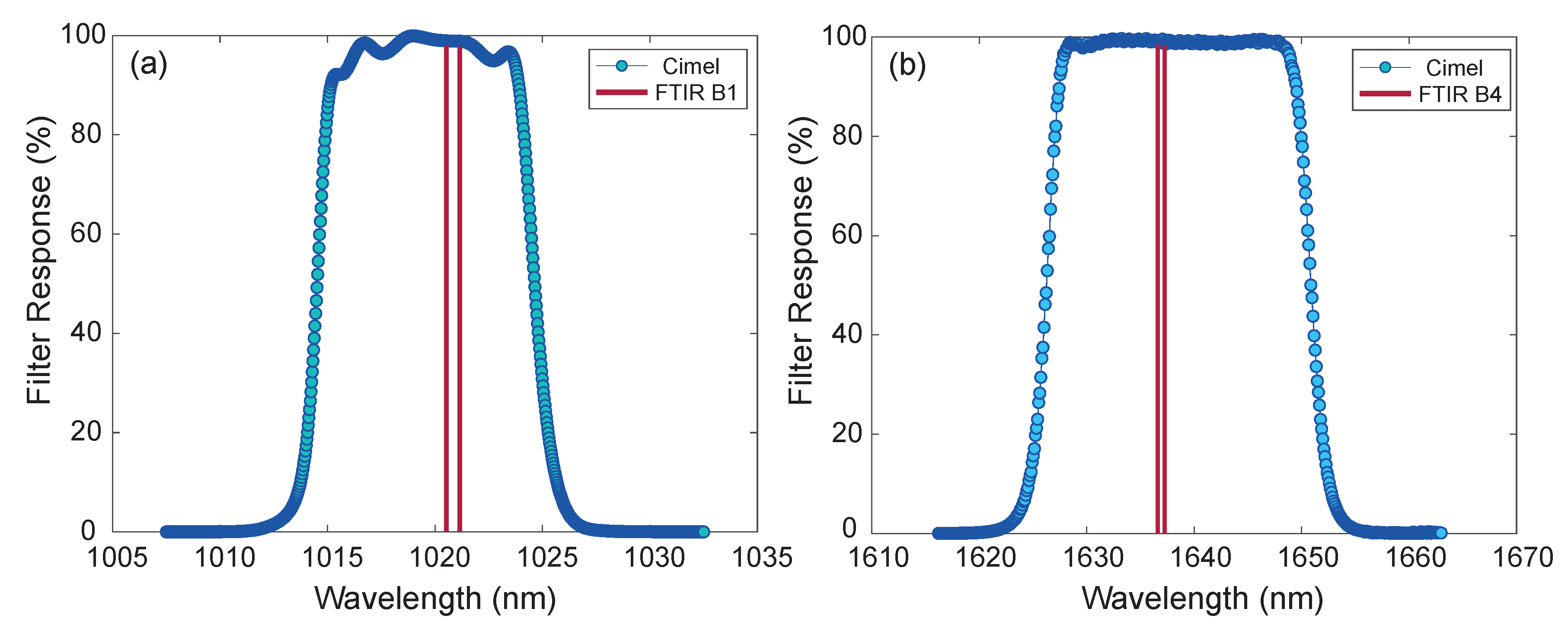

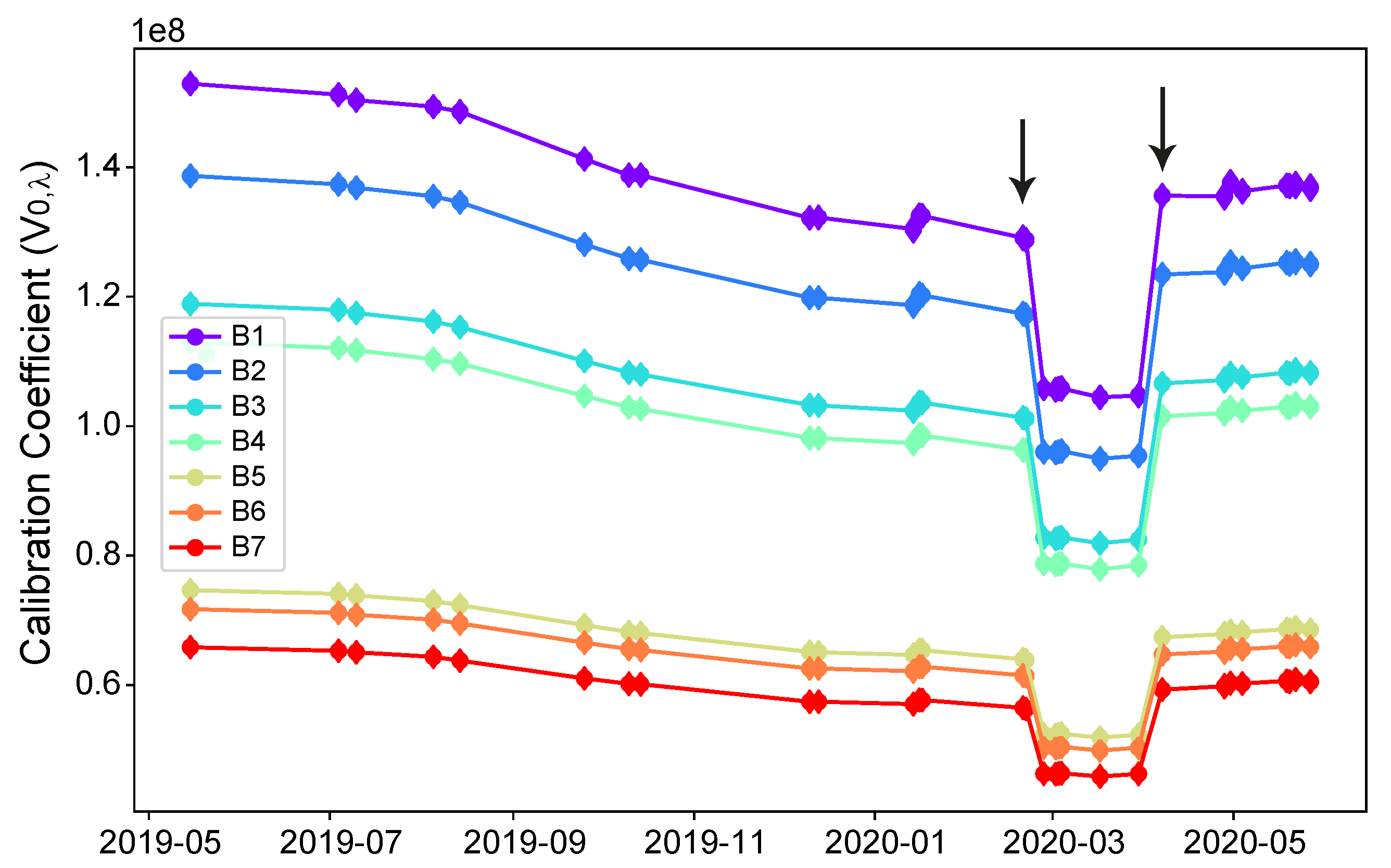

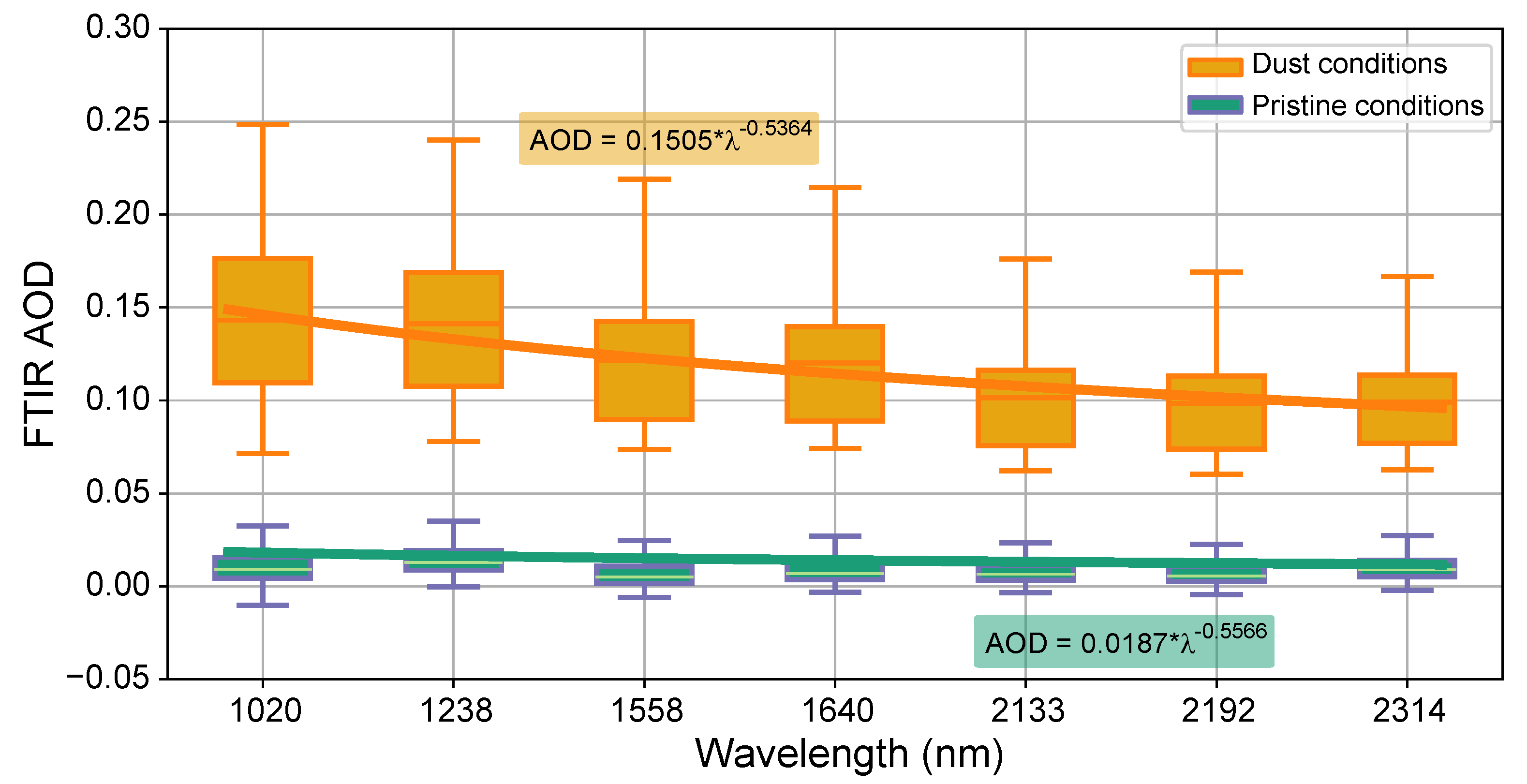
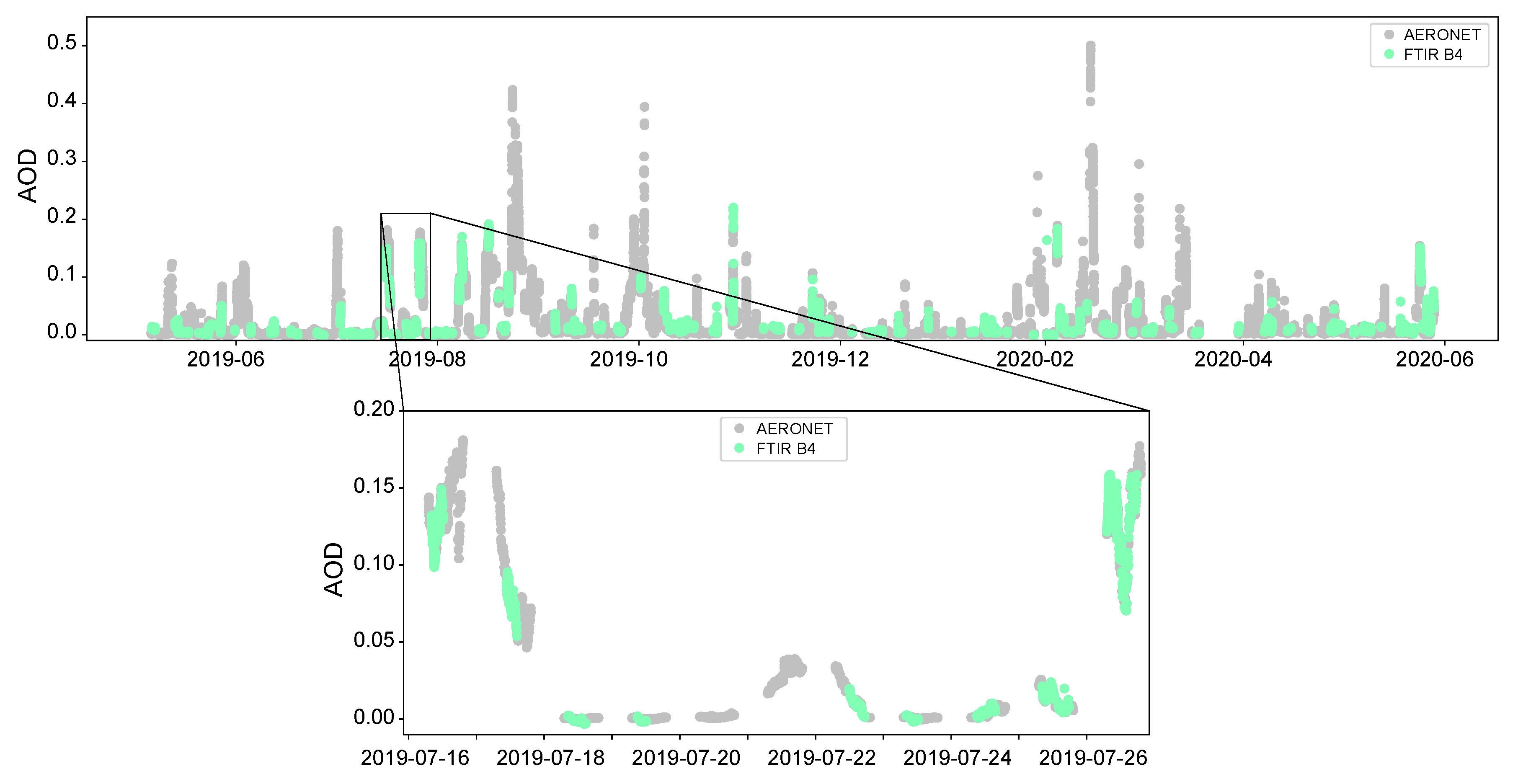
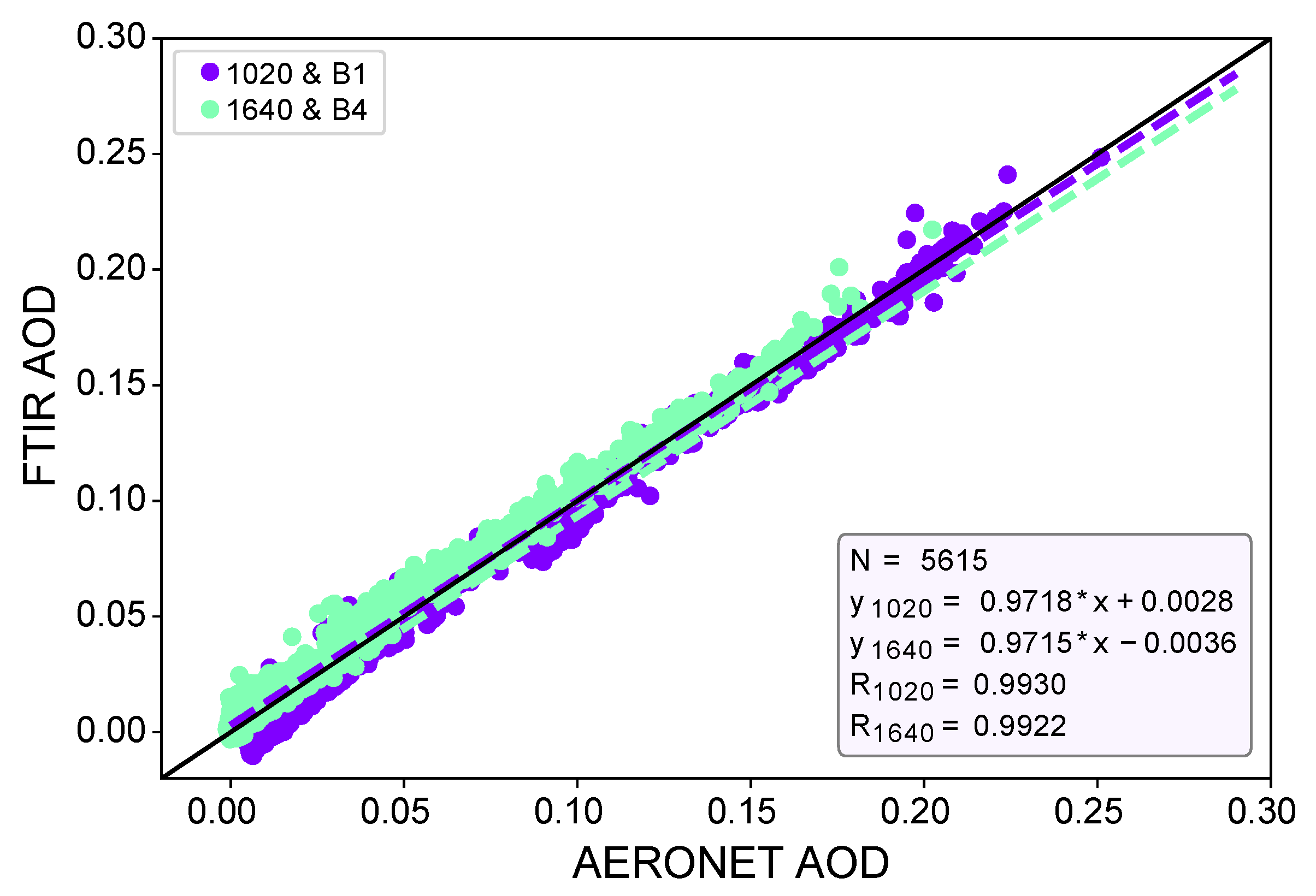
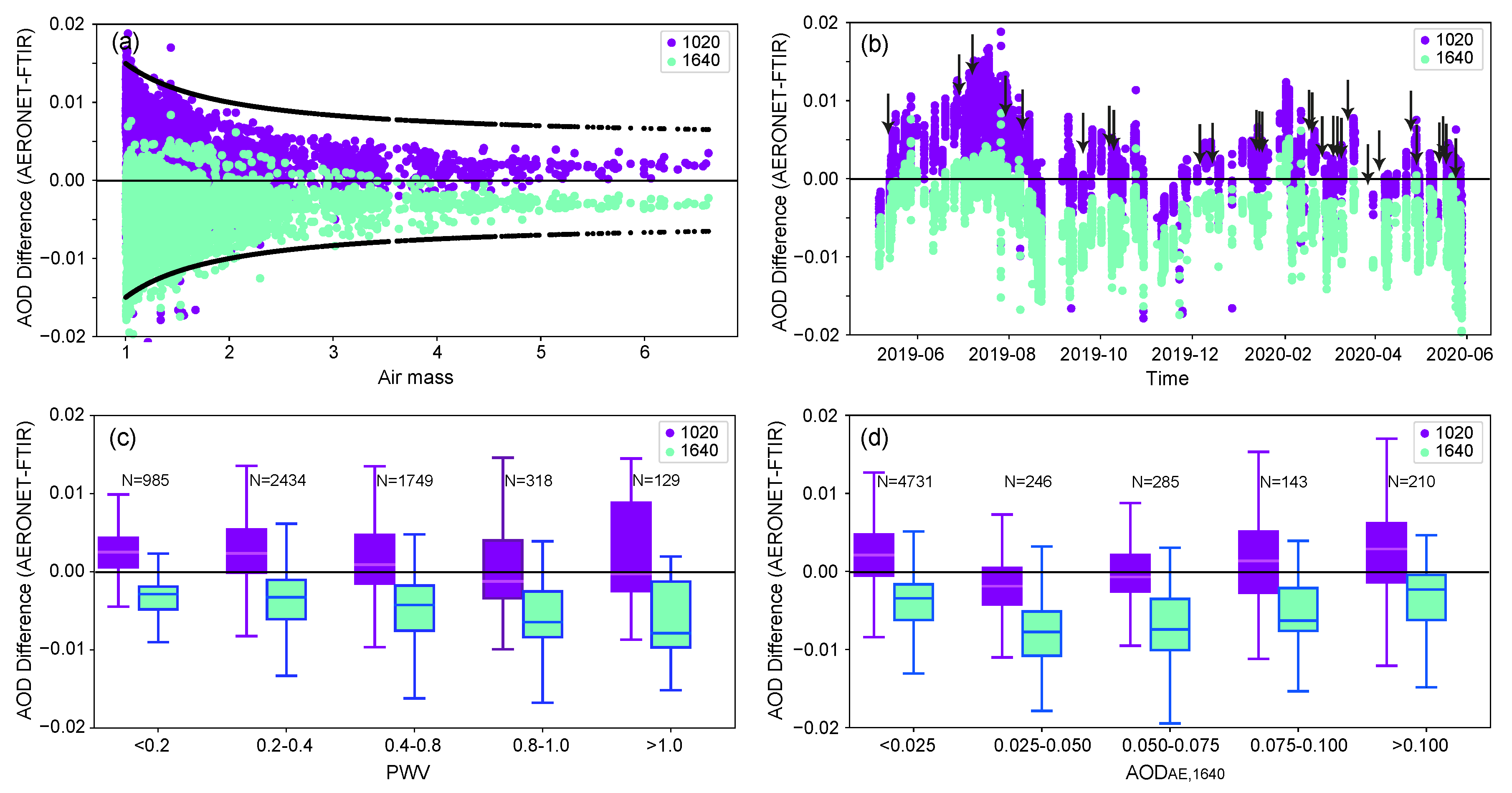
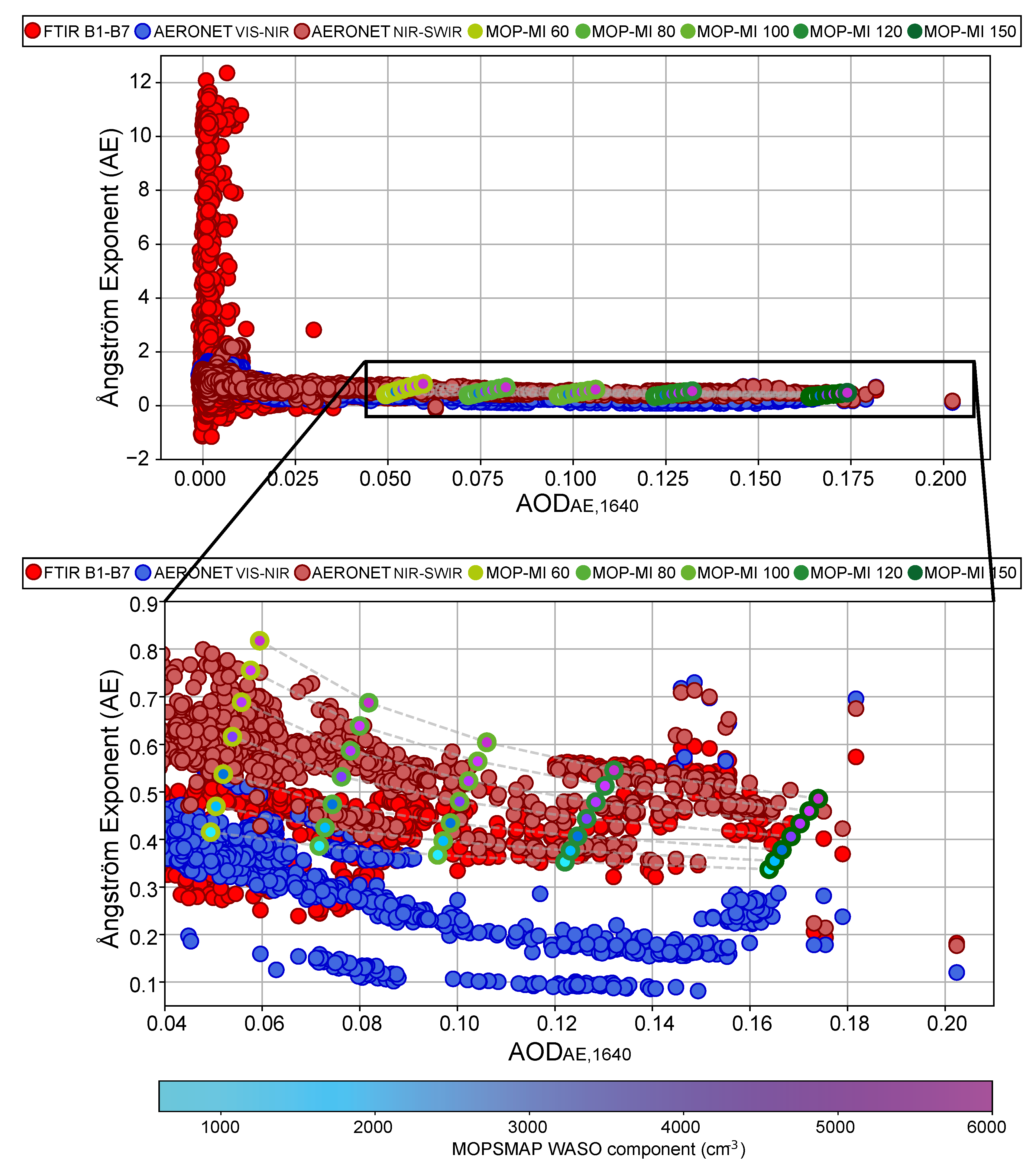
| Spectral Range | Bandwidth | Mean Transmittance | Transmittance CV | Transmittance CV |
|---|---|---|---|---|
| (nm) | (nm) | PWV = 2.5/15/25 mm | PWV = 2.5/15/25 mm (%) | Mean, (%) |
| B1: 1020.55–1021.25 | 0.7 | 0.9985/0.9982/0.9980 | 0.38/0.38/0.39 | 0.55, 0.04 |
| B2: 1237.75–1238.75 | 1 | 0.9983/0.9957/0.9934 | 0.35/0.83/1.38 | 0.52, 0.16 |
| B3: 1557.75–1558.75 | 1 | 0.9959/0.9944/0.9930 | 0.68/0.72/0.86 | 0.53, 0.03 |
| B4: 1635.50–1636.50 | 1 | 0.9845/0.9847/0.9847 | 0.89/0.89/0.89 | 1.28, 0.34 |
| B5: 2132.90–2133.90 | 1 | 0.9975/0.9970/0.9959 | 0.25/0.24/0.31 | 0.30, 0.07 |
| B6: 2191.50–2192.50 | 1 | 0.9971/0.9959/0.9947 | 0.43/0.43/0.45 | 0.61, 0.27 |
| B7: 2313.80–2314.60 | 0.8 | 0.9944/0.9934/0.9924 | 1.19/1.18/1.19 | 1.05, 0.13 |
| Spectral Band | B1: 1020.90 nm | B2: 1238.25 nm | B3: 1558.25 nm | B4: 1636.00 nm | B5: 2133.40 nm | |||||
| Langley Time Period | a.m. | p.m. | a.m. | p.m. | a.m. | p.m. | a.m. | p.m. | a.m. | p.m. |
| 3.9 | 6.8 | 2.7 | 3.6 | 2.7 | 2.7 | 2.8 | 2.4 | 2.4 | 2.0 | |
| R | −0.9994 | −0.9988 | −0.9998 | −0.9996 | −0.9982 | −0.9986 | −0.9991 | −0.9993 | −0.9988 | −0.9992 |
| Slope | −0.0138 | −0.0159 | −0.0135 | −0.0155 | −0.0041 | −0.0059 | −0.0058 | −0.0075 | −0.0043 | −0.0059 |
| 2.3 | 3.6 | 1.6 | 1.9 | 1.6 | 1.4 | 1.7 | 1.2 | 1.4 | 1.1 | |
| Intercept | 18.7364 | 18.7388 | 18.6453 | 18.6456 | 18.4994 | 18.4989 | 18.4497 | 18.4492 | 18.0438 | 18.0420 |
| 8.0 | 1.1 | 5.6 | 6.1 | 5.6 | 4.5 | 5.8 | 4.0 | 4.9 | 3.4 | |
| B6: 2192.00 nm | B7: 2314.20 nm | |||||||||
| Langley Time Period | a.m. | p.m. | a.m. | p.m. | ||||||
| 2.1 | 1.8 | 2.1 | 2.8 | |||||||
| R | −0.9980 | −0.9990 | −0.9990 | −0.9989 | ||||||
| Slope | −0.0031 | −0.0048 | −0.0050 | −0.0071 | ||||||
| 1.3 | 9.7 | 1.3 | 1.5 | |||||||
| Intercept | 18.0043 | 18.0026 | 17.9200 | 17.9182 | ||||||
| 4.4 | 3.1 | 4.4 | 4.7 | |||||||
| Micro-Windows | Convolution with CE318 | |||
|---|---|---|---|---|
| Response Function | ||||
| Spectral Band | 1020 nm | 1640 nm | 1020 nm | 1640 nm |
| MD | 0.0022 | −0.0042 | 0.0023 | 0.0012 |
| 0.0047 | 0.0040 | 0.0045 | 0.0037 | |
| RMSE | 0.0052 | 0.0057 | 0.0050 | 0.0039 |
| R | 0.9930 | 0.9922 | 0.9937 | 0.9933 |
| Slope | 0.9718 | 0.9715 | 0.9751 | 0.9762 |
| Intercept | 0.0028 | −0.0036 | 0.0029 | 0.0015 |
© 2020 by the authors. Licensee MDPI, Basel, Switzerland. This article is an open access article distributed under the terms and conditions of the Creative Commons Attribution (CC BY) license (http://creativecommons.org/licenses/by/4.0/).
Share and Cite
Barreto, Á.; García, O.E.; Schneider, M.; García, R.D.; Hase, F.; Sepúlveda, E.; Almansa, A.F.; Cuevas, E.; Blumenstock, T. Spectral Aerosol Optical Depth Retrievals by Ground-Based Fourier Transform Infrared Spectrometry. Remote Sens. 2020, 12, 3148. https://doi.org/10.3390/rs12193148
Barreto Á, García OE, Schneider M, García RD, Hase F, Sepúlveda E, Almansa AF, Cuevas E, Blumenstock T. Spectral Aerosol Optical Depth Retrievals by Ground-Based Fourier Transform Infrared Spectrometry. Remote Sensing. 2020; 12(19):3148. https://doi.org/10.3390/rs12193148
Chicago/Turabian StyleBarreto, África, Omaira Elena García, Matthias Schneider, Rosa Delia García, Frank Hase, Eliezer Sepúlveda, Antonio Fernando Almansa, Emilio Cuevas, and Thomas Blumenstock. 2020. "Spectral Aerosol Optical Depth Retrievals by Ground-Based Fourier Transform Infrared Spectrometry" Remote Sensing 12, no. 19: 3148. https://doi.org/10.3390/rs12193148
APA StyleBarreto, Á., García, O. E., Schneider, M., García, R. D., Hase, F., Sepúlveda, E., Almansa, A. F., Cuevas, E., & Blumenstock, T. (2020). Spectral Aerosol Optical Depth Retrievals by Ground-Based Fourier Transform Infrared Spectrometry. Remote Sensing, 12(19), 3148. https://doi.org/10.3390/rs12193148




